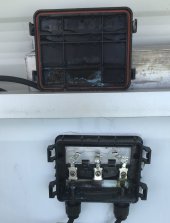I need to connect 12 250W solar panels into 6 parallel pairs. Each pair will be connected to the charging system using a pair of 6mm2 cables. I am not sure of the best way to make these parallel connections. The panels have 4mm2 leads, currently with MC4 connectors.
Should I:
A) Connect the panels with MC4 parallel branch connectors, then add the relevant MC4 connector to the 6mm2 cable.
B) Cut the MC4s off the panel leads and use some sort of butt crimp.
Some other details:
I would need to find a butt crimp that can join cables of slightly dissimilar sizes and work out a reliable way to weatherproof the connection.
I would really appreciate any advice you can offer.
Should I:
A) Connect the panels with MC4 parallel branch connectors, then add the relevant MC4 connector to the 6mm2 cable.
B) Cut the MC4s off the panel leads and use some sort of butt crimp.
Some other details:
- I need the paired panel setup as this is an Electrdacus SBMS0 based system.
- I have a typical hydraulic crimper, but would have to buy one for MC4 (I think?)
- This is going on an easily-accessible veranda roof, in a permanent installation.
- Since this is low voltage, I want to minimise the cable lengths as much as practical.
I would need to find a butt crimp that can join cables of slightly dissimilar sizes and work out a reliable way to weatherproof the connection.
I would really appreciate any advice you can offer.



